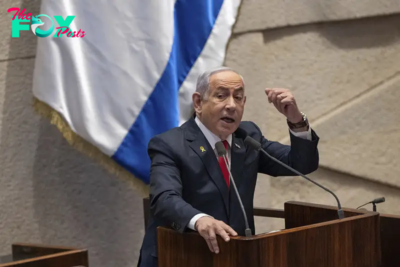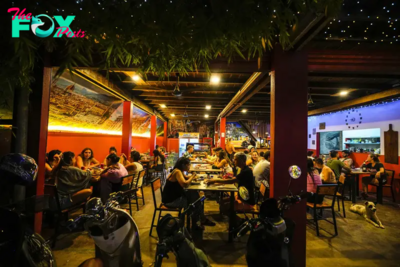World News
Thailand Celebrates Return of ‘Golden Boy’ in Rare Repatriation of Southeast Asian Artifacts
Thai and American officials celebrated the arrival of the so-called Golden Boy—a 4-ft. tall, about 900-year-old bronze statue—to the National Museum in Bangkok on Tuesday, after years of negotiations to repatriate the sculpture along with other artifacts that had been misappropriated abroad.
The return of the Golden Boy and the Kneeling Lady, another statue linked to the same alleged smuggler, was welcomed by Thai Minister of Culture Sudawan Wangsuphakijkosol as well as U.S. Ambassador to Thailand Robert F. Godec, who described the pieces as “symbols of Thailand’s rich heritage.”
They are “evidence of the prosperity of the land of Thailand in the past” and are “extremely important national cultural heritage,” Sudawan said on X.
Amid a wave of scrutiny over the potentially illicit provenance of artifacts sitting in the world’s largest museums, Southeast Asian governments have been trying to retrieve as many as thousands of items that they believe were looted or trafficked from their lands, though the repatriation process is often stalled or blocked by legal and logistical hurdles.
The return of the Golden Boy and the Kneeling Lady, which had spent the last three decades in the Metropolitan Museum of Art in New York, has been hailed as a rare success story.
Here’s what to know.
Why were the artifacts returned now?
A woman in northeastern Buriram province claims to have discovered the Golden Boy—which is believed by some to represent Hindu god Shiva and others to be Khmer King Jayavarman VI—about 50 years ago while digging for sweet potatoes. She says that when she brought the statue to a local police station, officers took her to Bangkok, where they sold it to a foreigner for 1.2 million baht (about $33,000).
When the Golden Boy was added to the Met’s collection in 1988, it was described by the museum as “certainly the most important gift of a Southeast Asian sculpture ever made to our collection.”
In December, the Met said that it would return the Golden Boy and the Kneeling Lady to Thailand, as well as 14 artifacts to Cambodia (including a metal sculpture of a sitting Bodhisattva Avalokiteshvara and a 7th-century stone Buddha head).
The pieces were associated with late art dealer Douglas Latchford, who was indicted in 2019 for trafficking and selling looted Cambodian antiquities to auction houses and museums around the world since the 1970s.
Until his death in 2020, Latchford had denied his involvement in smuggling, though his daughter agreed last year to forfeit $12 million from his estate to settle a civil lawsuit accusing him of profiting off stolen Cambodian artifacts.
“The Museum welcomes and takes very seriously any new information about objects in the collection and is dedicated to seeking resolutions as appropriate,” says the Met, which previously returned artifacts to Nepal and India after acknowledging that they were taken from ancient sites.
The Met agreeing to return the statue “is not a common occurrence,” Thai archaeologist Thanongsak Hanwong, a member of the government committee for the repatriation of stolen artifacts who says he spent more than three years working on the Golden Boy’s repatriation, told Benar News.
The Thai government has formally requested the return of about 30 artifacts that are scattered around the world, and its embassies are negotiating the return of 10 more items, Thanongsak added, as “some museums are reluctant to publicize these repatriations.”
What are other museums doing?
In recent years, calls have grown for Western museums—from the U.S. to the U.K., Australia, and Europe—to return artifacts that were allegedly looted from strife-torn regions across the world. According to prosecutors, Latchford started supplying major auction houses and museums with Cambodian antiquities during the country’s oppressive Khmer Rouge regime—and at times falsified the provenance of items to conceal the fact that they were illicitly obtained.
A 1970 UNESCO Convention lays down the legal basis to repatriate illegally exported cultural objects. However, critics have noted that the convention, which does not apply retroactively to cases before 1970, fails to protect items looted at the height of colonialism—a point that UNESCO has also acknowledged “remains a source of tension between countries with rich museum collections and those that demand the return of objects that contribute to their identity.”
The British Museum, dubbed “the world’s largest receivers of stolen property,” has dealt with yearslong allegations of housing pilfered antiquities and questions over its apparent secretiveness over certain artifacts. In April, the museum returned dozens of artifacts looted 150 years ago from the region of modern-day Ghana.
Museums across Europe, including the Netherlands, France, and Germany have also been repatriating stolen artifacts to their countries of origin in Southeast Asia. Observers say that the return of artifacts is a way for Europe to rehabilitate its controversial colonial legacy in the region. French President EMMAnuel Macron, who has said that he would “do everything possible” to return the symbols of cultural heritage France has looted—from Asia to Africa—pledged in January to return more Khmer artifacts to Cambodia.
But there’s still a long way to go, as museums and officials chip away at verifying the sources of a vast body of artifacts. (Reports say that the Met contains more than 1,000 items that may have been looted or trafficked.)
It’s also not just museums that have come under scrutiny. When photos made the rounds on social media earlier this year of oriental furniture, which online sleuths suspected had been pillaged from China in the 19th century, in British aristocrat Rose Hanbury’s house, calls erupted demanding their return.
“We are continuing to investigate the wide-ranging trafficking networks that … target Southeast Asian antiquities,” Manhattan District Attorney Alvin Bragg said in April, while announcing that 30 pieces of looted artifacts that authorities seized from museums and private collectors, estimated to be worth $3 million, would be returned to Cambodia and Indonesia. “There is clearly still much more work to do.”
-

 World News21h ago
World News21h agoWorld’s Best Brands – Brazil
-

 World News1d ago
World News1d agoWorld’s Best Brands – India
-

 World News2d ago
World News2d agoInternational Criminal Court Issues Arrest Warrants for Netanyahu and Hamas Commander
-

 World News2d ago
World News2d agoLandmark Bill to Ban Children From Social Media Introduced in Australia’s Parliament
-

 World News2d ago
World News2d agoAmerican and Australian Tourists Die in Laos After Drinking Tainted Alcohol
-

 World News2d ago
World News2d agoSee Photos of the Seventh Volcanic Eruption on Iceland’s Reykjanes Peninsula in 12 Months
-

 World News2d ago
World News2d agoMuhammad Yunus on the Race to Build Bangladesh 2.0
-

 World News2d ago
World News2d agoU.S. Charges Indian Billionaire Gautam Adani With Defrauding Investors


















